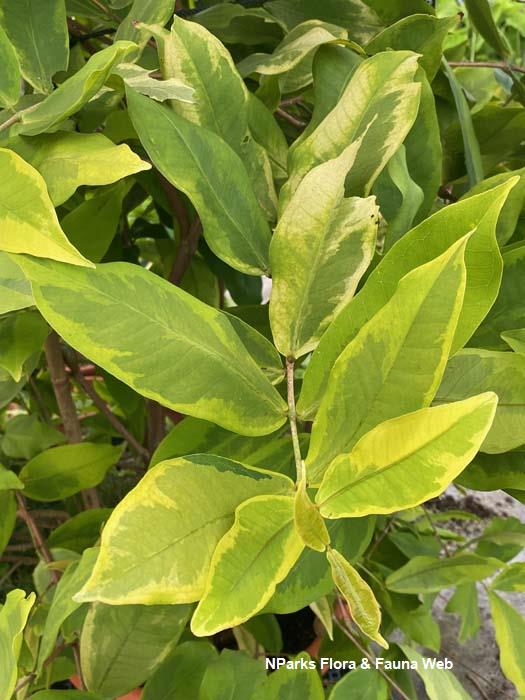.jpg)
Back
Syzygium papillosum (Duthie) Merr. & L.M.Perry
| Family Name: | Myrtaceae |
| Synonyms: | Eugenia papillosa Duthie |
| Common Name: | Kelat Paya |
Syzygium papillosum or Kelat Paya is a tall tree that grows to 30 m tall. The bark is papery, flaking, orange to dark brown coloured. It has shortly stalked leaves with a heart-shaped base or ear-like lobes and white, pom-pom shaped flowers produced on the upper branches in clusters.
Name
Classifications and Characteristics
| Plant Division | Angiosperms (Flowering Seed Plants) (Dicotyledon) |
|---|---|
| Plant Growth Form | Tree (Big (>30m)) |
| Lifespan (in Singapore) | Perennial |
| Maximum Height | 30 m |
Biogeography
| Native Distribution | Borneo, Malaya, Sumatera, Thailand and Singapore |
|---|---|
| Native Habitat | Terrestrial |
| Preferred Climate Zone | Tropical |
| Local Conservation Status | Native to Singapore (Critically Endangered (CR)) |
Description and Ethnobotany
| Growth Form | It is a tall tree of up to 30 m tall with orange to dark brown, papery, flaking bark. Branches and smaller branchlets are reddish-brown with little round bumps on its surface (papillose). |
|---|---|
| Foliage | Its leaves are shortly stalked, opposite, obovate-oblong shaped, measuring 33 - 34 cm long by 12 - 13 cm wide. The leaves have ear-like lobes or heart-shaped base with a intramarginal vein that connects the lateral veins along the margin. |
| Flowers | Its flowers are white, stalkless, pom-pom shaped, held on a cymose inflorescence. The flowering shoot measures up to 15 cm long, produced at the tips and axillary of the upper branches. |
| Habitat | Occurs along the edges of streams in evergreen, lowland swampy forest, up to 300 - 500 m in altitude. |
Landscaping Features
| Desirable Plant Features | Ornamental Flowers |
|---|
Plant Care and Propagation
| Light Preference | Full Sun |
|---|---|
| Water Preference | Moderate Water |
| Plant Growth Rate | Slow |
| Rootzone Tolerance | Fertile Loamy Soils, Moist Soils, Well-Drained Soils |
Foliar
| Foliage Retention | Evergreen |
|---|---|
| Mature Foliage Colour(s) | Green |
| Foliar Type | Simple / Unifoliate |
| Foliar Arrangement Along Stem | Opposite |
| Foliar Attachment to Stem | Petiolate |
| Foliar Shape(s) | |
| Foliar Venation | Pinnate / Net |
| Foliar Margin | Entire |
| Foliar Apex - Tip | Acute |
| Foliar Base | Cordate, Auriculate |
Non - Foliar and Storage
| Mature Bark Texture | Peeling / Flaking / Papery |
|---|---|
| Stem Type & Modification | Woody |
| Root Type | Underground (Tap Root) |
Floral (Angiosperm)
| Flower & Plant Sexuality | Bisexual Flowers , Bisexual Flowers |
| Flower Colour(s) | White |
|---|
| Flower Grouping | Cluster / Inflorescence |
| Flower Location | Axillary, Terminal |
| Flower Symmetry | Radial |
| Individual Flower Shape | Trumpet-shaped |
| Inflorescence Type | Cyme |
| Flowering Habit | Polycarpic |
References
| References | Parnell, J. & Chantaranothai P. (2002). Myrtaceae. Flora of Thailand, vol. 7. Bangkok: The Forest Herbarium, Royal Forest Department. pp. 778-914. |
|---|
Image Repository
Others
| Master ID | 30458 |
|---|---|
| Species ID | 4767 |
| Flora Disclaimer | The information in this website has been compiled from reliable sources, such as reference works on medicinal plants. It is not a substitute for medical advice or treatment and NParks does not purport to provide any medical advice. Readers should always consult his/her physician before using or consuming a plant for medicinal purposes. |

.jpg)


